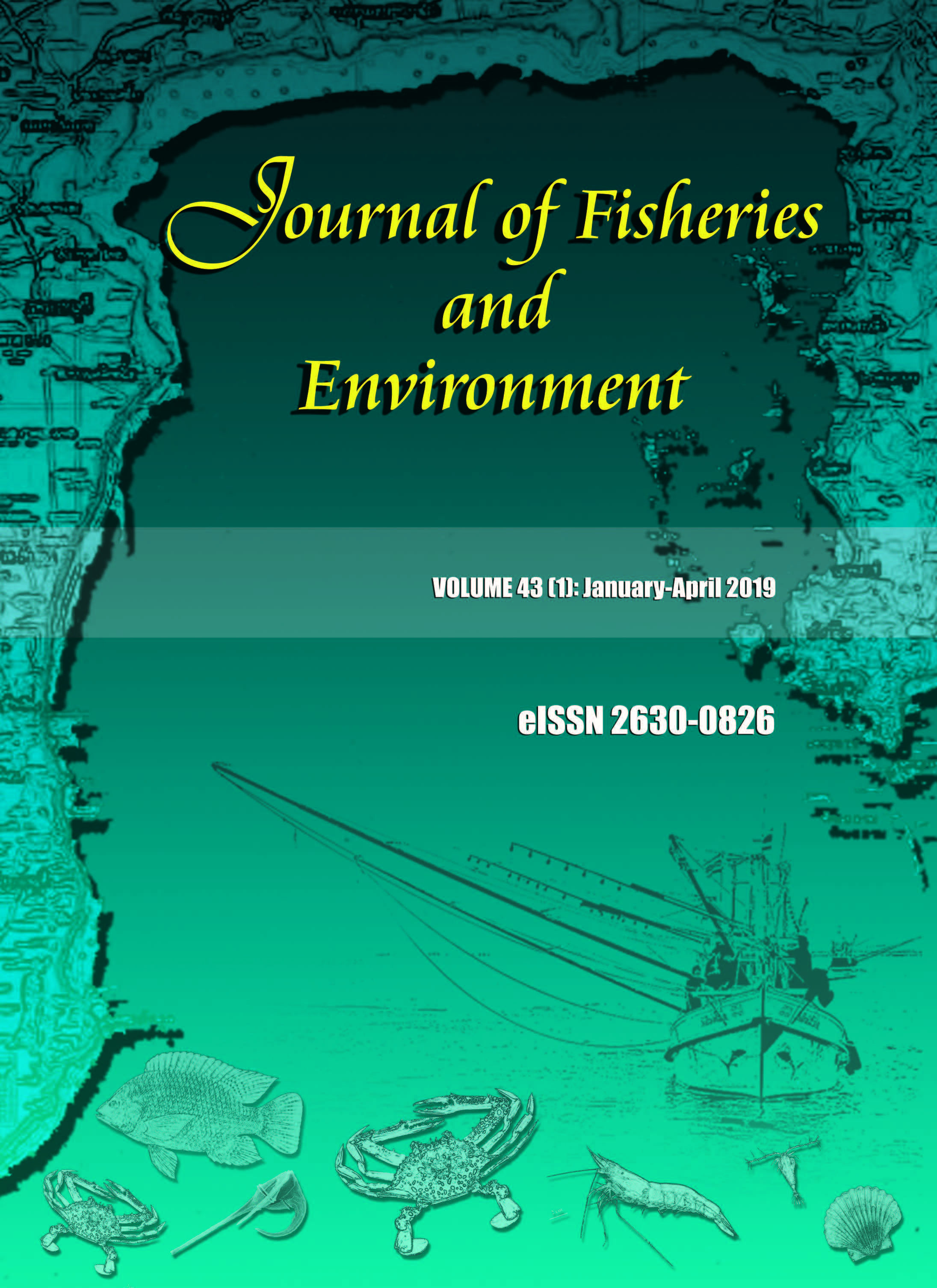Energy Transfer in Bang-tabun Bay from the Primary Producers to Primary Consumers
Main Article Content
Abstract
Energy transfer between trophic levels in Bang-tabun Bay was investigated during September 2012. Transfer was considered in terms of the carbon content in primary producers (phytoplankton) and primary consumers (zooplankton: copepods). Carbon content in phytoplankton varied between 563.22 and 3,492.70 mg·L-1 due to the abundance of nano- and pico-phytoplankton as the main source of carbon (62.8-92.0%). Carbon in copepods ranged between 21.97 and 278.51 mg·L-1. Energy transfer or trophic transfer efficiency ranged from 1.5% to 33.1%. Linear regression analysis showed a significant relationship between chlorophyll a and carbon content in phytoplankton at a significance level of 0.05 (F=41.332, p=0.000203). A linear correlation indicated with R2 of 81.8%, and this was used to estimate carbon content in phytoplankton when chlorophyll a concentration was known as a useful tool for energy transfer determination in aquatic environments.
Article Details
References
2. Boldrocchi, G., Y. Moussa Omar, D. Rowat, and R. Bettinetti. 2018. First results on zooplankton community composition and contamination by some persistent organic pollutants in the Gulf of Tadjoura (Djibouti). Science of The Total Environment
627: 812-821.
3. Das, K.R. and A.H.M.R. Imon. 2016. A brief review of tests for normality. American Journal of Theoretical and Applied Statistics 5 (1): 5-12.
4. Gaedke, U. and D. Straile. 1994. Seasonal changes of trophic transfer efficiencies in a plankton food web derived from biomass size distributions and network analysis. Ecological Modelling 75: 435-445.
5. Gaedke, U., D. Straile, and C. Pahl-Wostl. 1996. Trophic structure and carbon flow
dynamics in the pelagic community of large lake. In: Food Webs (ed. G. A. Polis and K.O. Winemiller), pp. 60-71. Springer, USA.
6. Gosselain, V., P.B. Hamilton, and J.P. Descy. 2000. Estimating phytoplankton carbon from microscopic counts: an application for riverine systems. Hydrobiologia 438: 75-90.
7. Heildelberg, K.B., K.L. O’Neil, J.C. Bythell, and K.P. Sebens. 2009. Vertical distribution and diel patterns of zooplankton abundance and biomass at Conch Reef, Florida Keys (USA). Journal of Plankton Research 32: 75-91.
8. Jennings, S., K.J. Warr, and S. Mackinson. 2002. Use of size-based production and stable isotope analyses to predict trophic transfer efficiencies and predator-prey body mass ratios in food webs. Marine Ecology Progress Series 240: 11-20.
9. Jo, N., J.J. Kang, W.G. Park, B. R. Lee, M.S. Yun, J.H. Lee, S. M. Kim, D. Lee, H. Joo, J.H. Lee, S.H. Ahn, and S.H. Lee. 2017. Seasonal variation in the biochemical compositions of phytoplankton and zooplankton communities in the southwestern East/Japan Sea. Deep Sea Research Part II: Topical Studies in Oceanography 143: 82-90.
10. Kemp, W. M., M. T. Brooks and R. R. Hood. 2001. Nutrient enrichment, habitat variability and trophic transfer efficiency in simple models of pelagic ecosystems. Marine Ecology Progress Series 223: 73-87.
11. Liang, W., D. Tang, and X. Luo. 2018. Phytoplankton size structure in the western South China Sea under the influence of a ‘jet-eddy system’. Journal of Marine Systems 187: 82-95.
12. Linderman, R.L. 1942. The trophic-dynamic aspect of ecology. Ecology 23: 399-417.
13. Ndour, I., A. Berraho, M. Fall, O. Ettahiri, and B. Sambe. 2018. Composition, distribution and abundance of zooplankton and ichthyoplankton along the Senegal-Guinea maritime zone (West Africa). Egyptian Journal of Aquatic Research 44: 109-124.
14. Parsons, T.R., Y. Maita, and C. M. Lalli. 1984. Determination of chlorophylls and total carotenoids: spectrophotometric method. In: A manual of chemical and biological methods for seawater analysis (ed. T.R. Parsons, Y. Maita, and C.M. Lalli), pp. 101-104. Pergamon Press, Oxford, UK.
15. Pauly, D. and V. Christensen. 1995. Primary production required to sustain global fisheries. Nature 375: 255-257.
16. Rousseau, V., S. Becquevort, J.Y. Parent, S. Gasparini, M.H. Daro, M. Tackx, and C. Lancelot. 2000. Trophic efficiency of the planktonic food web in a coastal ecosystem dominated by Phaeocystis colonies. Journal of Sea Research 43: 357-372.
17. Saikia, S.K. and S. Nandi. 2010. C and P in aquatic food chain L: A review on C:P stoichiometry and PUFA regulation. Knowledge and Management of Aquatic Ecosystems 398: 1-14.
18. Sanchez-Velasco, L. and B. Shirasago. 1999. Distribution and abundance of copepod nauplii in the vicinity of submarine canyon (NW Mediterranean). Revista de Biologia Tropical 47: 165-173.
19. Sanzone, D.M., J.L. Meyer, E. Marti, E.P. Gardiner, J.L. Tank, and N.B. Grimm. 2003. Carbon and nitrogen transfer from a desert stream to riparian predators. Oecologia 134: 238-250.
20. Schulz, M., R. Koschel, C. Reese, and T. Mehner. 2004. Pelagic trophic transfer efficiency in an oligotrophic, dimictic deep lake (Lake Stechlin, Germany) and its relation to fisheries yield. Limnologica 34: 264-273.
21. Zhang, W. and R. Wang. 2000. Summertime ciliate and copepod nauplii distributions and micro-zooplankton herbivorous activity in the Laizhou Bay, Bohai Sea, China. Estuarine Coastal and Shelf Science 51: 103-114.

